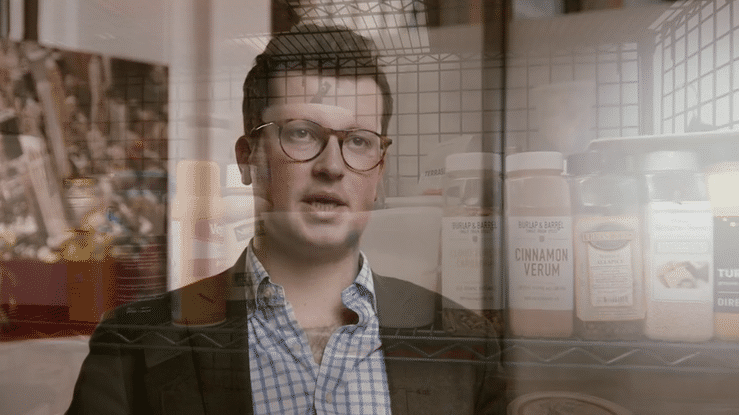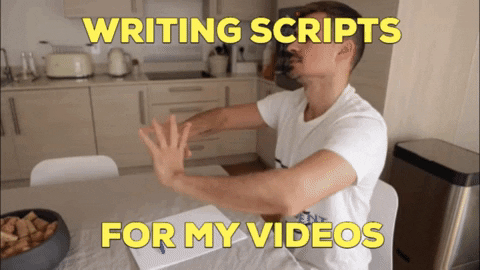
The Storyboard Media Group Blog
Unlocking Success: Harnessing the Power of Product Demonstration Videos
Launching a new product, or explaining a current one, are two scenarios that usually require a lot of planning and execution. Product videos - whether showcases or demonstrations - need to be on every single brands list of things-to-do.
In this post we talk about the things you must do to create video content that supports your goals and - most importantly - shows off your product in a big way.
This example - from a tech product demonstration video - uses the viewer’s POV to show how to use the features of a password security app that eliminates the need for remembering all your passwords.
Product demonstration videos are an incredibly powerful asset in any successful product and marketing strategy. With their ability to engage, educate, and captivate viewers, these videos provide a unique opportunity to showcase your product’s features, benefits, and use cases. By incorporating high-quality visuals, storytelling techniques, and interactive elements, you can create a compelling and immersive experience that allows potential customers to visualize your product in action, understand its value proposition, and ultimately make an informed buying decision.
Top 5 Features of Product Demonstration Videos:
1. Concise and Engaging Content: Product demonstration videos should be crafted to deliver information concisely and engagingly. By showcasing the key features and functionalities of your product in an easily digestible format, you can quickly capture your audience’s attention and leave a lasting impression.
2. Visual Storytelling: Videos have a unique ability to convey information through visuals. Product demonstration videos harness this power by weaving a compelling story around your product and creating a memorable experience that resonates with viewers long after they’ve watched the video.
3. Interactive Elements: To enhance viewer engagement, product demonstration videos often incorporate interactive elements such as annotations, clickable links, or even virtual reality (VR) experiences. These features allow potential customers to explore your product further, delve into specific features, and interact with the video content, fostering a deeper connection with your brand.
4. High Production Quality: Investing in professional video production ensures that your product is showcased in the best possible light. High-quality visuals, polished editing, and immersive sound design create a sense of professionalism and credibility, instilling confidence in potential customers and positioning your brand as a leader in the industry.
5. Multi-channel Distribution: Product demonstration videos can be shared across various channels, including your website, social media platforms, email campaigns, and even in-store displays. This versatility allows you to reach a wider audience and ensure that your message is delivered to potential customers wherever they are.
A short clip from a product demonstration video created for the De’longhi brand to showcase the use and features of their new air fryer. The video, and several companion shorts, were used in email campaigns, in retail stores, on their website and on Amazon.
Top 5 Benefits of Product Demonstration Videos:
1. Increased Conversion Rates: By visually demonstrating your product’s features and benefits, product demonstration videos provide potential customers with a clearer understanding of how your product solves their pain points. This increased clarity often translates into higher conversion rates and a greater likelihood of making a purchase.
2. Enhanced Brand Awareness: Compelling video content has the potential to generate buzz around your brand and increase its visibility. When viewers find value in your content, they are more likely to share it with their networks, leading to exponential reach and heightened brand awareness.
3. Improved Customer Engagement: Product demonstration videos offer an immersive experience that goes beyond static images or text-based descriptions. By engaging multiple senses and delivering information in an entertaining manner, these videos capture and retain viewer attention, fostering a stronger connection with your brand.
4. Competitive Edge: In today’s saturated marketplace, standing out from the competition is crucial. Product demonstration videos allow you to showcase your product’s unique features and benefits in a visually compelling way, differentiating your brand and giving you a competitive edge.
5. Customer Education and Support: Beyond the initial purchase, product demonstration videos can serve as valuable educational resource for existing customers. By providing detailed tutorials, troubleshooting guides, or best practices, these videos help customers derive maximum value from your product and reduce the burden on your support teams.
Our client provides secure, remote, key-less entry systems for businesses and private use. We used storytelling to show a ‘day-in-the-life’ of an average user, and how to use the system.
The video included 4 actors, 2 locations and 2 days to film.
Top 5 Use Cases of Product Demonstration Videos:
1. Product Launches: Introducing a new product to the market can be challenging. Product demonstration videos enable you to create anticipation and generate excitement by offering a sneak peek into your latest innovation. By highlighting key features and showcasing the product in action, you can build anticipation and drive early adoption.
2. Sales Enablement: Sales teams can leverage product demonstration videos as powerful tools during their conversations with potential customers. These videos help sales representatives communicate complex product features effectively, address objections, and create a compelling case for why the product is the perfect solution for the customer’s needs.
3. E-commerce and Online Retail: With the rise of e-commerce, product demonstration videos have become indispensable for online retailers. These videos provide a virtual shopping experience, allowing potential customers to see the product from different angles, understand its functionality, and make more informed purchasing decisions.
4. Training and Onboarding: For companies offering software or technical products, product demonstration videos serve as invaluable training and onboarding resources. These videos walk users through the product’s interface, demonstrate key features, and guide users in harnessing the product’s full potential, reducing the learning curve and improving user satisfaction.
5. Customer Testimonials and Case Studies: Product demonstration videos can feature customer testimonials and case studies, highlighting real-world success stories. By showcasing how your product has positively impacted other customers’ businesses, you build trust and credibility, making potential customers more confident in choosing your solution.
Top 3 Ways Video Product Demonstrations Allow Potential Customers to Visualize the Product in Action and Understand its Value Proposition:
1. Immersive Experience: Product demonstration videos provide a dynamic and immersive experience, enabling potential customers to visualize the product in action. By showcasing real-life scenarios and demonstrating how the product solves specific pain points, viewers gain a clearer understanding of how the product will benefit them.
2. Feature Demonstrations: Video allows for a detailed exploration of each feature, ensuring potential customers grasp the full extent of what your product can do. By highlighting specific features and their functionality, you showcase the product’s value proposition and its unique selling points.
3. Contextual Relevance: Through storytelling and relatable narratives, product demonstration videos create a context that resonates with potential customers. By demonstrating the product’s relevance to their lives or business challenges, viewers can envision how the product will fit seamlessly into their daily routines or operational workflows.
Here's Exactly What to Look for When Hiring a Video Production Team
If you have a creative initiative with lots of moving parts, hiring the right production team can be critical to its success.
In this post, we want to start from the beginning. You've consulted with internal stakeholders, you want to take on a creative idea with lots of moving parts, and you know that hiring the right production team will be critical to its success.
Now you're ready to hire your dream team. Naturally, the next question becomes... "what exactly do I look for?" The following provides a few attributes to consider when hiring the best production team for your business.
Our Motto:
Based on years of partnering with clients of all sizes and types building startups, expanding brands, and planning major events, we know that teamwork and collaboration are the core of any successful corporate video project.
In this post, we want to start from the beginning. You've consulted with internal stakeholders, you want to take on a creative idea with lots of moving parts, and you know that hiring the right production team will be critical to its success.
Now you're ready to hire your dream team. Naturally, the next question becomes... "what exactly do I look for?" The following provides a few attributes to consider when hiring the best production team for your business.
Scalability
You want a production team that can scale their service and capabilities... and tailor them exactly to your project. This goes beyond simple shooting and editing, but seeing a project through from ideation to total manifestation.
A good way to think about this is to consider the difference between a door-to-door car service vs. DIY airport parking.
In one scenario, you're navigating traffic, obstacles, and schedules on your own; while in the other, you're trusting your capable driver to anticipate challenges, take the unnecessary burdens off your plate, and ensure that everything is buttoned up flawlessly and on-time.
Full-service video production starts with helping you finalize your concept and flows on through to some of the following tasks:
Script support
Casting acting and voice over talent
Scouting and securing locations
Gear - lots of it
Filming
Editing
Animating
All the little extras- lighting, backdrops, even hair and makeup
Consultation on how this video will meet your business goals
It's important to consider how much assistance you may need and choose an agency that can scale accordingly to your project.
Creativity
Having access to an innovative video production team is also crucial to a successful project. Your team should be able to help you brainstorm creative ideas.
If you get the sense that they take a paint by numbers approach to creating and editing videos, they may not be up to date on the marketing and visual trends that will move the needle on your goals.
Questions to ask yourself when hiring a creative video production team, include:
Do I feel like I'm seeing something fresh?
Was I truly interested as I watched their videos?
Did I feel entertained and/or educated when I checked out their blog?
Did I ask myself 'How did they do that?'
Does all of their sample work look the same?
Do they work with a diverse set of companies and industries?
Is their work professional and consistently of the highest quality?
Therefore, when it comes to innovation, bookmark the video production houses that showcase range and keep your attention.
Trustworthiness
Ask for references. Say you're evaluating several agencies - customer references may make all the difference in ensuring that everything is as it seems below the surface.
Any good video company should be able to proudly showcase their past work on their website and social channels with client branding/logos, detailed success stories, and behind-the-scenes case studies.
Yes, sometimes client privacy/ proprietary information is an issue but any agency lacking a good amount of this type of concrete information may not have the experience you need.
Open Communication
Great communication means you will always have insight into the real-time status of your project, the direction it is headed, and what the end result will be. The key to good communication for a production company is listening.
A good sign you have the right team in your sights is when they spend more time learning about your brand and business than they do selling themselves.
If your agency is easy to connect with, goes above and beyond to offer suggestions, and answers questions quickly and completely, all signals are GO!
Project Management Gurus
A super important skill set often missed as an oversight in selecting a video production company- Project Management.
It is vital that the agency you hire is highly adept at managing projects. A team with stellar PM skills is the most effective way to maintain a level of hustle, organization and urgency to the flow of the creative process.
Expertise
An experienced production team will have the ability to demonstrate a deep range of samples across styles (cinematic, minimalist, guerilla), industries (fashion, tech, food), and different methods (animation, live action, drone footage, events, testimonials, short form video, advertising, etc).
This range of skill is important because video content and the marketing industry are always changing— and only an expert can stay on top of the shifting trends. When you find that your project is completed on time, on budget and providing next-level creativity, it may just shock you.
Tech and Digital Savviness
Regardless of your intended use, modern video production is about all things digital marketing. Therefore, you need a tech-savvy, plugged-in team to guide you. A great team will understand things like:
And beyond the above, should provide you with special insight into:
Trending hardware and software -
When to use 4K cameras, 360 degree video, VR tech, Live and Interactive videoDigital marketing initiatives -
Inbound, Outbound, Customer Lifetime Value, Conversion BenchmarksBranded social advertising and awareness -
The impact of posting times and content types across Facebook, Twitter, LinkedIn and InstagramEngagement rates-
On email vs. ads, when to use comedy, music or silence with just text on screenAnd so much more...
A great team understands how marrying the science of technology through analytics, formats and channels to art, can create a truly effective piece of video content.
Goal Oriented
Lastly, you need a video production team that is results driven.
You're not in sync if you're the only one gloriously racing for the finish line. Your team should be interested in delivering a superior-quality product that consistently delivers on your priorities.
It doesn't matter the type or intent of the video; be it crowdfunding, training, generating more sales and/or leads, delighting customers, capturing a new audience, or showing your fun side. At the end of the day, you started this search and video project with a concrete goal in mind. Your production agency should make achieving that objective both rewarding and effortless.
What Makes a Great Testimonial Video
Testimonial videos remain one of the best and most important ways of telling audiences about your product or service. But there’s a right way to do them, and some simple rules to follow to make sure you’re doing it right.
This blog post let’s you see how your plan compares to the rules we work from with examples and tips.
What makes a great testimonial video? Can the answer boil down to just one word? We think so. That word is ‘story’.
We’ll grant that we hear this word thrown around quite a lot. Every brand wants to tell a story - to tell their story. Even though it sometimes seems the word is overused, there really is something to it.
WHAT IS “STORY?”
In the example video below, we don’t just hear about the product. We hear first-hand knowledge of someone whose day-to-day has been impacted by it. The product is an intercom system that solves all kinds of problems. The story told by the interviewee is about challenges, personal experiences, the solution given by the intercom system, and how it has positively impacted his work routines. We hear that the unit his company installed is saving time, saving money, and saving misunderstandings.
Of course, we still need to see the product in a real-world use scenario – this video wouldn’t be complete without that. But it’s more about the story.
And one small note: Take notice of how the recommendation, and description of the product, is made right at the start of the video
WHAT OTHER KIND OF “STORY” IS GOOD FOR A TESTIMONIAL VIDEO?
Some clients and brands need extremely personal stories told to impact an audience. In the legal world, decisions about who to turn to in times of personal tragedy can be a big one. We hear from a law firm’s client that after an accident, his life became difficult and he didn’t know what to do or where to turn. For our legal firm client’s audience, this is very important to see in a video. It helps them understand they’re not alone and there is somewhere to turn, and someone that can help.
To help make a more impactful video, it starts with a moment in which things changed forever.
WHAT ARE YOUR FIRST STEPS IN CREATING A TESTIMONIAL VIDEO?
Not all testimonial video are built the same, and they shouldn’t be. But there are ‘rules’ to follow that can be helpful:
First things first: Getting buy-in from an outside person (a client for example) who is familiar with your brand can be a challenge in getting permissions and approvals, and scheduling the necessary block of time on their calendar. Start early.
The person(s) in the video should have first-hand knowledge of the product or service that is being covered. This gives the personal touch that is needed.
The person(s) should speak from the heart so that the audience knows they’re sincere. This means no coaching before the interview, and no memorizing of answers. The interviewee(s) can certainly have advance notice of the questions they’ll be asked so they have ideas about what to say, but that’s about as much as they need before sitting down in front of the camera.
Make sure to ask the right questions of the interviewee(s). First, you need to know what you want the audience to know about your product or service. Then, craft questions that will get answers that cover that messaging.
Don’t forget b-roll - that’s the footage that we add along with the interview to give context and life. B-roll is shown in the two examples above.
Choose people for your video based on their ability to speak clearly about their experiences.
How to Write a Video Marketing Script
Video marketing is a critical component of an overarching marketing strategy, and a good script is essential. It ensures your audio will align with your visuals in a way that hooks your viewer, advances your story, and incentivizes your audience to think, feel, or take a specific action.
Here’s our advice for creating a great script.
Video marketing is a critical component of an overarching marketing strategy, and good scriptwriting is essential. However, it’s not a skill set many marketers learn about or have had to do that often. But It’s more important than ever.
Your video script will act as a blueprint for the video production team. It ensures your audio will align with your visuals in a way that hooks your viewer, advances your story, and incentivizes your audience to think, feel, or take a specific action.
Here’s our advice for creating a great script.
Start with a Brief
Before you can start writing, you really need to know the goal of your video. The brief should provide the important information you need to direct your writing.
A brief should include information about your audience, where they are in the marketing or sales funnel, which platforms you’ll show the video on, and what you want viewers to think, feel, or do after watching your video.
Armed with this information, you’re ready to begin writing.
Draft the Script, but First a Few Tips
Plan for about 125 to 150 words of dialogue per minute. That’s a perfect pace for narration, interviews or voice overs.
For a script, you’ll want to write the way we speak. So as you write it, it’s good practice to read it out loud and see if it sounds the way you would say it. If something is weird, you’ll feel it as you read it.
Read it aloud to other people on the team. If something gets by you, they’ll catch it.
Time yourself while reading in front of others. They can tell you if you’re speed is right, and you’ll know how long your video is going to be. If you want a 60 second video and your read is 75 seconds, you can cut something out or change the wording to hit that 1 minute mark.
Write Your Script in Sections
Your video should follow some basic guidelines for best results. There are four parts that you should include in almost every script.
1. The Opening
Your opening dialogue should be attention-getting. You’ll want to set up an emotional hook, a surprising fact, or a relatable story to engage your viewer and keep them watching.
Often, this when you want to introduce a problem, issue or need to your viewer. Once you’ve grabbed their attention, your goal is to keep them engaged. Tell them exactly why they should care or how this problem impacts them.
2. Present the Solution
Where there is a problem there is also a solution, and you have it. Your product, service or offer needs to be presented as a solution for their issues. It’s also the only one they should consider for the following reasons:
3. Explain Why You, Why Now
In this section, you want to delve a bit deeper into why your viewer needs this solution, now from you and only you. There is something unique about what you do, sell, or provide that nobody else has. Maybe it’s faster, more affordable, or exceptional. Tell them.
4. The Call to Action
The call to action is a critical component of your video that many skip. This is a critical mistake. The viewer won’t take action because you didn’t ask them to! You want your viewer to do something after watching your video. Tell them what that is and how they can easily do it. You might even offer an incentive, if possible.
Script Formatting
Now that you know what you’re going to say, you can pair your words with your visuals. You can format your script in many ways, but the clearest can be a simple two-column table like the one below.
Other options include putting visuals cues in parentheses or italics before or after the dialogue. Work with your production crew to see if they have a preferred format.
In summary
Once you pair the audio and visuals, you’ll have a good idea of what you’ll need to film, the props and set you’ll need, and other elements to support your script and video length. You don’t have to be a literary major to write a great script, but you do need to know what your message is and why you’re delivering it.
What Makes a Great Product Video?
You might only have seconds to capture your customer’s attention with a video to get them interested in your product. Or maybe they’ve come to your website because they’ve heard about you and want to know more. We talk about how to use video to introduce your product, show off its best features, and get conversions.
Shots from a 1-minute product video we created for a beautiful line of watches.
We’ve had the opportunity to create product videos for a wide range of clients. This includes luxury watches, diamonds, highly-engineered umbrellas, high-fashion eye wear and more. We have some ideas for what makes a really good product video.
First things first; Why would you need a product video? There are many reasons which are not limited to:
Launching a new product
Relaunching a product after updating it or rebranding
Refreshing your digital content
Reaching and making inroads with a brand new audience
Raising capital
Showcasing your product at conferences, trade shows
All these reason are very important, so it’s also important to do this right.
1: MAKE IT LOOK GOOD
The right lighting, camera, angles and movement can make all the difference in how your product looks.
Of course, the first thing you need is beautiful product shots. This makes sense, right? Otherwise, what’s the point of your video. But it’s not just about ‘taking pictures’ or ‘shooting some video.’ There’s a lot more to think about. You need to use the right lighting, the right angles, the right camera lenses. Even choosing the right background is important. The point is to show off your product in the best way possible - professionally and beautifully.
2: ENGAGE THE VIEWER
You need to tell the story of your product. That might be the history of the blood, sweat and tears that brought it into existence. Or it could be the story of how your product is helping, or will help, people. It could even be an inspirational story that tells how your product makes people feel.
3: MAKE IT ABOUT MORE THAN THE PRODUCT
What do sushi, candles and flowers have to do with a product video?
Your product is the star of its own product video, but viewers will probably start to lose interest if all they see if product shots - even if those shots are beautiful. So you need to show your product in action. Use lifestyle shots, actors - whatever it takes to create to interest in addition to your product.
As an example, one of our clients provides a video intercom system that makes life easier and more secure for businesses and residences. Using product shots alongside lifestyle shots, we were able to show told a ‘day in the life’ story of someone who lives in a building with the intercom system. We brought in actors to be the main character, a delivery person, a girlfriend and a dog walker. We even got sushi and flowers for a ‘date night.’
4: KNOW YOUR COMPETITIVE EDGE
In addition to sexy product shots, make sure you tell the audience what is special about your product. How does it help people, what can it do for them specifically, what challenges does it address? Is it just something to have fun with like a game, a toy or a new bicycle lineup? How is it different from all the other choices out there?
4: KNOW YOUR AUDIENCE
In the end, one of the above matters if you don’t know your audience. So make sure your messaging speaks to them in a way they can appreciate and understand. Evoke the right emotions to make them stay interested. Give your video the right personality by using humor, facts, an inspirational feel.
Let our team make your team a great video. Your product and our expertise will go a long way.

























